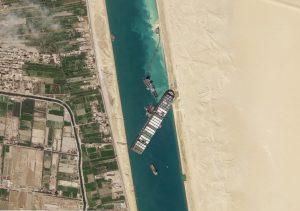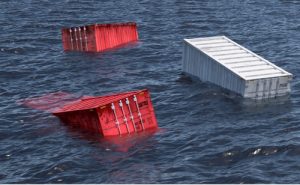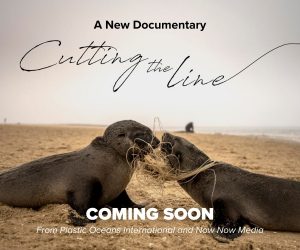International Cargo Lost At Sea Is Adding to Plastic Pollution Crisis
In March of this year, when the cargo ship Ever Given became stuck in the Suez canal, blocking a critical trade route for hundreds of cargo ships, there was scarcely a person in the world who did not hear about the news. The incident shone a light on the sheer scale of the shipping industry, that most-present and yet little-seen form of mass movement of goods.

This satellite image shows the cargo ship MV Ever Given stuck in the Suez Canal, Sunday, March 28, 2021. (Planet Labs Inc. Via AP)
It is unsurprising, therefore, that there is almost no global awareness of the fact that thousands of shipping containers have plunged to the ocean floor over the years. Largely this is as a result of unpredictable weather, poor stowage, and inadequate supervision, amongst other issues – but whatever the why, the bottom line is that containers are disappearing into the depths at an alarming rate, especially over the past year. Over 1,000 containers have fallen overboard in the first five months of 2021, and on November 30th of last year we saw over 1,800 containers lost at sea from one ship alone.
Whilst a few thousand containers may sound like a pittance compared to the millions of containers which successfully arrive at their intended destination, a small percentage of a lot of something is still a very high number, as statisticians regularly state.
As such, the destructive effect they are having on marine ecosystems is far from trivial. When the containers reach the ocean floor they frequently rupture due to pressure or impact, with debris being released into the water. If, as is often the case, the container contains plastics with a density close to or less than that of the water, the debris will be whisked off by currents to beaches and other marine ecosystems around the world.

Shipping containers lost at sea. Photo: FoxPictures
“In 2012, I witnessed a cargo spill in Hong Kong that resulted in a beautiful coastline covered in plastic beads, as the ship just sailed away with no accountability,” said Julie Andersen, CEO of Plastic Oceans International. “That was a turning point for me.”
Perhaps the most famous example of this occurred in 1992, when the Evergreen Ever Laurel, traveling between Hong Kong and Tacoma, Washington, rolled 40 degrees in a storm and lost 12 cargo containers into the freezing depths. Among these were a shipment of 29,000 rubber ducks, which for design reasons had no hole in the bottom, and therefore would take on no water. Thus, many of these ducks began a voyage which circumnavigated the globe, giving researchers vast data for study of ocean currents and other related fields. Though such an experiment could never have been ethically licensed, the inadvertent side effect of the Ever Laurel’s loss is that, using the ducks – nicknamed ‘Friendly Floatees’ – oceanographers can now track currents and predict how far plastics will travel when they are released into the water.
Rubber ducks notwithstanding, a recent study by the University of Plymouth and the Lost at Sea project, which tracked a spill of HP ink cartridges in 2014, which occurred 1.5 km east of New York, has shown the true reach of debris from cargo container spills. Using the nexus between science and social media to combine sightings reported by the public with oceanographic modeling tools, the researchers found that the cartridges had spread as far as Cape Verde and the Arctic Circle.
What the beachcombers could not have ascertained, however, is the extent to which the cartridges had already degraded in the sea, and how much they will continue to degrade as they float their way around the waterways of the world. As well as being contaminated with a range of materials such as titanium, iron, and copper, the cartridges will also bake brittle under the sunshine and disintegrate into shards of plastic which will, in turn, crumble into even smaller particles which are ingested by animals at the very foundations of the food chain. Indeed, the polypropylene shells of the HP cartridges collected for study already showed visible deterioration, and given that it is thought that plastics can survive up to 1,000 years in the ocean, it’s not too great a leap to see how pervasive the invasion of microplastics at all levels of the global ecosystem will be for centuries to come.
As yet, there are no stringent reporting guidelines for the loss of shipping containers; indeed there is no obligation to declare that a container has been lost overboard unless it contains items which are ‘hazardous’ and ‘likely to pose an immediate risk to the environment’.
“We must continue to raise awareness about the harm created by human accidents like these,” said Andersen. “It’s also imperative that companies be held accountable for the impact of their products’ full lifecycle … from their makeup and manufacturing, through their distribution, sale and end-of-life disposal.”
Of course, with our increasing awareness of the effects of deterioration of plastics in the oceans, it seems ludicrous to only class substances which are causing visible and imminent problems as an issue – a case of people turning a blind eye where something does not need to be dealt with immediately.
As Dr Andrew Turner, Associate Professor in Environmental Sciences at the University of Plymouth, explains, these events “also call into question the relevance and robustness of current instruments and conventions that deal with plastic waste and its accidental loss at sea.”
About Shannon Collins
Shannon Collins is based in the Americas and covers environment and sustainability for a variety of publications as part of the journalism team at Ninth Wave Global.

